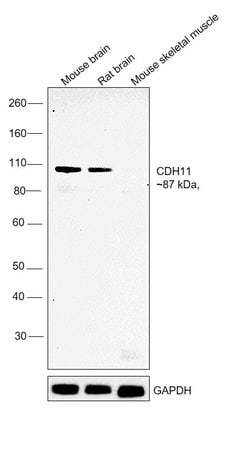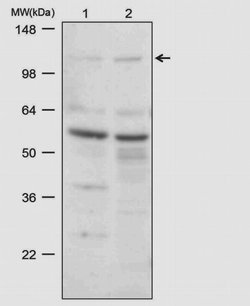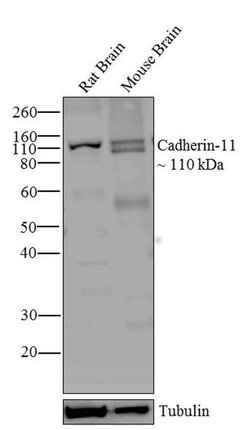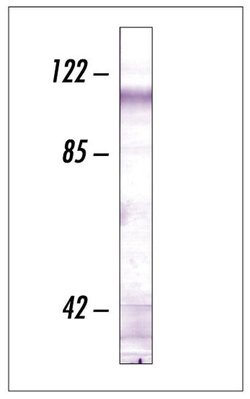Learn More
Invitrogen™ CDH11 Monoclonal Antibody (5B2H5)
Mouse Monoclonal Antibody
Supplier: Invitrogen™ 321700

Description
This antibody is specific for the ~110 kDa Cadherin 11 protein. Cross-reactivity with other Cadherin family members has not been observed. This antibody is confirmed reactive with human and mouse Cadherin 11. Reactivity was confirmed on western blots using MDA.MB231 cells (human) and mouse L fibroblast lysates. For Immunohistochemistry of frozen sections, incubate 30-60 minutes at room temperature or overnight at 4°C.
This gene encodes a type II classical cadherin from the cadherin superfamily, integral membrane proteins that mediate calcium-dependent cell-cell adhesion. All cadherins are single-pass transmembrane proteins with a variable number of 110 amino acid extracellular cadherin (EC) domains. Classical cadherins contain five large N-terminal EC domains, a single membrane-spanning domain, and a small, highly conserved C-terminal cytoplasmic domain. Based on amino acid alignment, classical cadherins are divided into type I and type II subgroups. Type I cadherins, including cadherins E (epithelial), N (neural), P (placental), and R (retinal) cadherin differ from type I cadherins in their specific amino acid sequences. Type II cadherins include human cadherin-5, -6, -8, -11, and -12. Type II cadherins are defined based on their lack of a HAV cell adhesion recognition sequence specific to type I cadherins. Cadherin-11 (OB-Cadherin) is a marker of the loosely connected and migratory cellular elements of the mesenchyme. Strong expression of Cadherin-11 has been noted in brain, spinal cord, bone marrow and bone cells, and is regulated in human endometrial glandular epithelial and stromal cells. Expression of this particular cadherin in osteoblastic cell lines, and its upregulation during differentiation, suggests a specific function in bone development and maintenance. A variant Cadherin-11 gene (variant form) encodes a truncated protein with an unusual cytoplasmic domain not present in other cadherins. The variant protein is generated by alternative splicing, utilizing a 179 bp intronic sequence. Recently, Cadherin-11 mRNA and protein were found to be expressed in most invasive breast cancer cell lines tested but not in non-invasive cell lines, suggesting that Cadherin-11 may be a marker for aggressive, invasive tumor subsets.
Specifications
| CDH11 | |
| Monoclonal | |
| 0.5 mg/mL | |
| PBS with 0.1% sodium azide; pH 7.4 | |
| P55287, P55288 | |
| CDH11 | |
| Recombinant protein derived from an intracellular sequence of the human Cadherin 11 protein. | |
| 100 μg | |
| Primary | |
| Human, Mouse | |
| Antibody | |
| IgG1 κ |
| Immunohistochemistry, Immunoprecipitation, Western Blot | |
| 5B2H5 | |
| Unconjugated | |
| CDH11 | |
| CAD11; Cad-11; Cadherin; cadherin 11; cadherin 11, type 2, OB-cadherin (osteoblast); cadherin-11; Cdh11; CDHOB; OB; OB Cadherin; OB-cadherin; OSF-4; Osteoblast cadherin; osteoblast-cadherin | |
| Mouse | |
| Protein A | |
| RUO | |
| 1009, 12552 | |
| -20°C | |
| Liquid |
Safety and Handling
The Fisher Scientific Encompass Program offers items which are not part of our distribution portfolio. These products typically do not have pictures or detailed descriptions. However, we are committed to improving your shopping experience. Please use the form below to provide feedback related to the content on this product.




